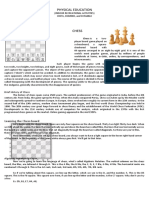0 ratings0% found this document useful (0 votes)
64 viewsChess: Presented By: Juvelyn Damuag
Chess: Presented By: Juvelyn Damuag
Uploaded by
Juvz DamuagChess is a board game played between two players that originated in India over 1500 years ago and has evolved into its current form. The objective is to checkmate the opponent's king by placing it under immediate attack where it cannot escape. Each of the 16 pieces on each side have specific movements and the goal is to checkmate the opponent. Chess involves strategy without hidden information and is governed by international rules and organizations.
Copyright:
© All Rights Reserved
Available Formats
Download as PPTX, PDF, TXT or read online from Scribd
Chess: Presented By: Juvelyn Damuag
Chess: Presented By: Juvelyn Damuag
Uploaded by
Juvz Damuag0 ratings0% found this document useful (0 votes)
64 views21 pagesChess is a board game played between two players that originated in India over 1500 years ago and has evolved into its current form. The objective is to checkmate the opponent's king by placing it under immediate attack where it cannot escape. Each of the 16 pieces on each side have specific movements and the goal is to checkmate the opponent. Chess involves strategy without hidden information and is governed by international rules and organizations.
Original Title
CHESS
Copyright
© © All Rights Reserved
Available Formats
PPTX, PDF, TXT or read online from Scribd
Share this document
Did you find this document useful?
Is this content inappropriate?
Chess is a board game played between two players that originated in India over 1500 years ago and has evolved into its current form. The objective is to checkmate the opponent's king by placing it under immediate attack where it cannot escape. Each of the 16 pieces on each side have specific movements and the goal is to checkmate the opponent. Chess involves strategy without hidden information and is governed by international rules and organizations.
Copyright:
© All Rights Reserved
Available Formats
Download as PPTX, PDF, TXT or read online from Scribd
Download as pptx, pdf, or txt
0 ratings0% found this document useful (0 votes)
64 views21 pagesChess: Presented By: Juvelyn Damuag
Chess: Presented By: Juvelyn Damuag
Uploaded by
Juvz DamuagChess is a board game played between two players that originated in India over 1500 years ago and has evolved into its current form. The objective is to checkmate the opponent's king by placing it under immediate attack where it cannot escape. Each of the 16 pieces on each side have specific movements and the goal is to checkmate the opponent. Chess involves strategy without hidden information and is governed by international rules and organizations.
Copyright:
© All Rights Reserved
Available Formats
Download as PPTX, PDF, TXT or read online from Scribd
Download as pptx, pdf, or txt
You are on page 1of 21
CHESS
PRESENTED BY: JUVELYN DAMUAG
HISTORY:
The history of chess can be traced back nearly 1500
years to its earliest known predecessor, called
chaturanga, in India; its prehistory is the subject of
speculation.
From India it spread to Persia. Following the Arab
invasion and conquest of Persia, chess was taken up by
the Muslim world and subsequently spread to southern
Europe. The game evolved roughly into its current form
by about 1500 CE.
Chess spread directly from the Middle East to Russia,
where chess became known as шахматы (shakhmaty,
literally "checkmates", a plurale tantum).
HISTORY:
it had survived a series of prohibitions and Christian
Church sanctions to almost take the shape of the modern
game.
Modern history saw reliable reference works,
competitive chess tournaments, and exciting new
variants. These factors added to the game's popularity,
further bolstered by reliable timing mechanisms (first
introduced in 1861), effective rules, and charismatic
players.
HISTORY:
Organized chess arose in the 19th century.
Chess competition today is governed internationally by
FIDE (International Chess Federation).
The first universally recognized World Chess Champion,
Wilhelm Steinitz, claimed his title in 1886; Magnus
Carlsen is the current World Champion.
A huge body of chess theory has developed since the
game's inception. Aspects of art are found in chess
composition; and chess in its turn influenced Western
culture and art and has connections with other fields
such as mathematics, computer science, and
psychology.
HISTORY:
One of the goals of early computer scientists was to
create a chess-playing machine.
In 1997, Deep Blue became the first computer to beat
the reigning World Champion in a match when it
defeated Garry Kasparov.
Though not flawless, today's chess engines are
significantly stronger than even the best human players,
and have deeply influenced the development of chess
theory.
o Chess is a board game played between
two players.
o Itis sometimes called Western chess,
or international chess to distinguish it
from related games such as xiangqi.
o The current form of the game emerged
in Southern Europe during the second
half of the 15th century after evolving
from similar, much older games of
Indian and Persian origin. Today, chess
is one of the world's most popular
games, played by millions of people
worldwide.
OBJECTIVE :
o Chess is an abstract strategy game and
involves no hidden information.
o It is played on a square chessboard with 64
squares arranged in an eight-by-eight grid.
At the start, each player (one controlling the
white pieces, the other controlling the black
pieces) controls sixteen pieces: one king, one
queen, two rooks, two knights, two bishops,
and eight pawns.
o The object of the game is to checkmate the
opponent's king, whereby the king is under
immediate attack (in "check") and there is no
way for it to escape. There are also several
ways a game can end in a draw.
RULES :
o Chess pieces are divided into two different
colored sets. While the sets may not be
literally white and black (e.g. the light set
may be a yellowish or off-white color, the
dark set may be brown or red), they are
always referred to as "white" and
"black".
o The players of the sets are referred to as
White and Black, respectively. Each set
consists of 16 pieces: one king, one queen,
two rooks, two bishops, two knights, and
eight pawns. Chess sets come in a wide
variety of styles; for competition, the
Staunton pattern is preferred.
RULES :
o The game is played on
a square board of eight
rows (called ranks) and
eight columns (called
files).
o on White's first rank,
from left to right, the
pieces are placed in the
following order: rook,
knight, bishop, queen,
king, bishop, knight,
rook.
RULES :
o On the second rank is
placed a row of eight
pawns.
o Black's position mirrors
White's, with an
equivalent piece on the
same file.
o The correct positions of
the king and queen may
be remembered by the
phrase "queen on her
own color" ─ i.e. the
white queen begins on a
light square; the black
queen on a dark square.
MOVEMENTS:
o In competitive games,
the piece colors are
allocated to players by
the organizers;
o in informal games, the
colors are usually
decided randomly, for
example by a coin toss,
or by one player
concealing a white pawn
in one hand and a black
pawn in the other, and
having the opponent
choose.
MOVEMENTS:
o White moves first, after
which players alternate
turns, moving one piece
per turn.
o A piece is moved to
either an unoccupied
square or one occupied
by an opponent's piece,
which is captured and
removed from play.
o Moving is compulsory;
a player may not skip a
turn, even when having
to move is detrimental.
MOVEMENTS:
o Each piece has its own
way of moving. In the
diagrams, the dots mark
the squares to which the
piece can move if there
are no intervening
piece(s) of either color
(except the knight, which
leaps over any
intervening pieces).
MOVEMENTS:
o All pieces except the
pawn can capture an
enemy piece if it is
located on a square to
which they would be
able to move if the
square was unoccupied.
The squares on which
pawns can capture
enemy pieces are marked
in the diagram with black
crosses.
KING MOVEMENT
The king moves one square
in any direction. There is also
a special move called
castling that involves
moving the king and a rook.
The king is the most valuable
piece — attacks on the king
must be immediately
countered, and if this is
impossible, immediate loss
of the game ensues.
https://www.youtube.com/wa
tch?v=FcLYgXCkucc
ROOK MOVEMENT
o A rook can move any
number of squares along
a rank or file, but cannot
leap over other pieces.
Along with the king, a
rook is involved during
the king's castling move.
BISHOP MOVEMENT
o A bishop can move any
number of squares
diagonally, but cannot
leap over other pieces.
QUEEN MOVEMENT
o A queen combines the
power of a rook and
bishop and can move any
number of squares along
a rank, file, or diagonal,
but cannot leap over other
pieces.
KNIGHT MOVEMENT
o A knight moves to any of
the closest squares that are
not on the same rank, file,
or diagonal. (Thus the
move forms an "L"-shape:
two squares vertically and
one square horizontally, or
two squares horizontally
and one square vertically.)
The knight is the only
piece that can leap over
other pieces.
PAWN MOVEMENT
o A pawn can move forward to the
unoccupied square immediately in
front of it on the same file, or on
its first move it can advance two
squares along the same file,
provided both squares are
unoccupied (black dots in the
diagram). A pawn can capture an
opponent's piece on a square
diagonally in front of it by moving
to that square (black crosses). A
pawn has two special moves: the
en passant capture and promotion.
o En passant https://
www.youtube.com/watch?v=c_KRIH0wnh
E
o Promotion https://
www.youtube.com/watch?v=Tt8VTZFPF
a4
THANK YOU!!!!
You might also like
- History of Chess: Fen/PgnDocument1 pageHistory of Chess: Fen/PgnAiswariya RNo ratings yet
- Chess HandoutDocument10 pagesChess HandoutKristine AngubNo ratings yet
- Summary of The Moves of Chess: A Powerpoint Presentation by Jason KibbeDocument20 pagesSummary of The Moves of Chess: A Powerpoint Presentation by Jason Kibbekhudal100% (1)
- Description of Board and PiecesDocument15 pagesDescription of Board and PiecesMarc Marc MarcNo ratings yet
- CHESSDocument36 pagesCHESSCilena Domenicina100% (2)
- HistoryDocument3 pagesHistoryHenry RafaelNo ratings yet
- Chess 8Document5 pagesChess 8bethanyNo ratings yet
- Pe ChessDocument29 pagesPe ChessCharles Ramonal Pogoy BawaanNo ratings yet
- Chess InstructionsDocument6 pagesChess InstructionsAngucciNo ratings yet
- History of ChessDocument5 pagesHistory of ChessRenmar BaccayNo ratings yet
- ChessDocument26 pagesChessRowelyn Noora100% (2)
- Project IN Mapeh: Submitted By: Ella Mae A. Aurestila Submitted To: Ms. Marifel MaslogDocument6 pagesProject IN Mapeh: Submitted By: Ella Mae A. Aurestila Submitted To: Ms. Marifel MaslogElla Anil AurestilaNo ratings yet
- The History of ChessDocument18 pagesThe History of ChessScribdTranslationsNo ratings yet
- Who Invented Chess?: Individual Who Invented The Established Game Because It Is FarDocument30 pagesWho Invented Chess?: Individual Who Invented The Established Game Because It Is FarRaniel TalastasNo ratings yet
- The History of ChessDocument3 pagesThe History of ChessKristy Dela CernaNo ratings yet
- Q3-P e - ChessDocument30 pagesQ3-P e - Chessviduyatheo6No ratings yet
- Who Invented Chess?: Individual Who Invented The Established Game Because It Is FarDocument30 pagesWho Invented Chess?: Individual Who Invented The Established Game Because It Is FarRaniel TalastasNo ratings yet
- Illustrated Rules of ChessDocument9 pagesIllustrated Rules of ChessO'Neil RobinsonNo ratings yet
- Chess: Presented By: Brylle A. Patayon Presented To: GPE4 CLASS (8082Document14 pagesChess: Presented By: Brylle A. Patayon Presented To: GPE4 CLASS (8082Brylle PatayonNo ratings yet
- ChessDocument11 pagesChessjap japNo ratings yet
- History of ChessDocument3 pagesHistory of ChessJyasmine Aura V. AgustinNo ratings yet
- Chess: Mat Is An Arabic Phrase Which Means "The King Is Dead." The WordDocument6 pagesChess: Mat Is An Arabic Phrase Which Means "The King Is Dead." The WordJessa Mae CacNo ratings yet
- Chess-guide (1)Document29 pagesChess-guide (1)std16-172No ratings yet
- CHESSDocument17 pagesCHESSJohn Robert GasbanNo ratings yet
- Chess Learners GuideDocument9 pagesChess Learners GuideJames BayocotNo ratings yet
- Lecture ChessDocument25 pagesLecture Chesses rodulfaNo ratings yet
- Chess Pre TestDocument9 pagesChess Pre TestSuazo Jessa0% (1)
- Pawns (8 Pieces) : Chess Piece NamesDocument5 pagesPawns (8 Pieces) : Chess Piece NamesAdam HafizNo ratings yet
- ChessDocument15 pagesChessapi-269460675No ratings yet
- The Origin of Chess Is Obscure: Where Did Chess Come From? Was It Invented by A SingleDocument2 pagesThe Origin of Chess Is Obscure: Where Did Chess Come From? Was It Invented by A Singleanon_954345839No ratings yet
- Physical Education: Learning The Chess BoardDocument8 pagesPhysical Education: Learning The Chess BoardPamela CambiNo ratings yet
- Rules of ChessDocument15 pagesRules of ChesssomenathNo ratings yet
- How To Play ChessDocument22 pagesHow To Play Chessraj202987_47312067No ratings yet
- AssgdyDocument10 pagesAssgdydonescatherinejoyNo ratings yet
- Edphys10 - BG - ModuleDocument47 pagesEdphys10 - BG - ModuleAaron Tzergio GotohNo ratings yet
- Home Map of China Created in China About China Chinese Way Art Q&A Curiosity Institutions/Troupes China in ClassroomDocument2 pagesHome Map of China Created in China About China Chinese Way Art Q&A Curiosity Institutions/Troupes China in ClassroomPursuit HiNo ratings yet
- Chess GuideDocument8 pagesChess GuidegetdhanrajNo ratings yet
- Chess For Beginners A Picture G - Al HorowitzDocument315 pagesChess For Beginners A Picture G - Al Horowitzgingerbd69No ratings yet
- Q3-P.E.-CHESSDocument37 pagesQ3-P.E.-CHESSRosary MagdasocNo ratings yet
- Grade 8-CHESSDocument28 pagesGrade 8-CHESSRevilyn JosonNo ratings yet
- Learning ChessDocument25 pagesLearning ChessAKHIWU EhidiamhenNo ratings yet
- ChessDocument8 pagesChessRio TakashiNo ratings yet
- Physical Education Project FileDocument17 pagesPhysical Education Project FileAnirudha Thakur100% (10)
- Learn To Play ChessDocument9 pagesLearn To Play ChessayeahescoberNo ratings yet
- The Rules of ChessDocument4 pagesThe Rules of ChessPeter Adrian NgoNo ratings yet
- Hks 125 Board GamesDocument48 pagesHks 125 Board Gamesikponmwosavera1No ratings yet
- Chess Game To PrintDocument12 pagesChess Game To PrintScribdTranslationsNo ratings yet
- Origin: It Originated in India Over The 15Document3 pagesOrigin: It Originated in India Over The 15Shiela Joy Valdez AradoNo ratings yet
- ChessDocument7 pagesChessBaheerullah WardakNo ratings yet
- PE 2 Lesson 6 ChessDocument29 pagesPE 2 Lesson 6 ChessRolando GalloNo ratings yet
- ChessDocument1 pageChessweeselking78No ratings yet
- Chess RulesDocument2 pagesChess RulesPramod ShawNo ratings yet
- WrittenReport CHESS BSN12HDocument17 pagesWrittenReport CHESS BSN12HROGELIO JR ROSALEJOSNo ratings yet
- Chess Game With Two Players: 2. Literature Review and RulesDocument10 pagesChess Game With Two Players: 2. Literature Review and RulesRaghavendran Venkatesan100% (2)
- Kid's Guide to Chess: Learn the Game's Rules, Strategies, Gambits, and the Most Popular Moves to Beat Anyone!—100 Tips and Tricks for Kings and Queens!From EverandKid's Guide to Chess: Learn the Game's Rules, Strategies, Gambits, and the Most Popular Moves to Beat Anyone!—100 Tips and Tricks for Kings and Queens!No ratings yet
- REVIEWER-IN-CHESSDocument4 pagesREVIEWER-IN-CHESSfrinzallizandrewrNo ratings yet
- Robot CharactersDocument4 pagesRobot CharactersDan SmithNo ratings yet
- Probability WSDocument5 pagesProbability WSmahak agarwalNo ratings yet
- Master Thesis Game ProgrammingDocument6 pagesMaster Thesis Game Programmingmariapolitepalmdale100% (2)
- Live Cricket Scores, Match Schedules, Latest CricDocument1 pageLive Cricket Scores, Match Schedules, Latest Cricvdesai1056101No ratings yet
- D1ragonix - Character Options, Talents IIDocument61 pagesD1ragonix - Character Options, Talents IIValdir Barbosa0% (1)
- Reto 3. How To Act ResponsiblyDocument4 pagesReto 3. How To Act ResponsiblyJulio DelgadoNo ratings yet
- Van Richten S Guide To The Vistani (2e)Document98 pagesVan Richten S Guide To The Vistani (2e)Mr Powers100% (2)
- III2Document13 pagesIII2AngelepalerNo ratings yet
- Explorers RPG - Character Sheets - Rev 1Document6 pagesExplorers RPG - Character Sheets - Rev 1António DurãoNo ratings yet
- English File 4th Edition Intermediatepdf CompressDocument169 pagesEnglish File 4th Edition Intermediatepdf CompressThomas BarbosaNo ratings yet
- PE02CO2 Module Basic Skills of Volleyball - PANGUITO 2Document10 pagesPE02CO2 Module Basic Skills of Volleyball - PANGUITO 2Irish CodmNo ratings yet
- Example PomDocument3 pagesExample PomjossmadibaNo ratings yet
- AP-patched GamesDocument12 pagesAP-patched GamesJuan PintoNo ratings yet
- Biographical Elements of Dominican Softball and Baseball AthletesDocument7 pagesBiographical Elements of Dominican Softball and Baseball AthletesScribdTranslationsNo ratings yet
- Leveling Guide by DesMephistoDocument7 pagesLeveling Guide by DesMephistoFoxx RenardNo ratings yet
- Reglas Torneos LorcanaDocument11 pagesReglas Torneos Lorcanak7sdw2jynwNo ratings yet
- Sci-Damath GameDocument33 pagesSci-Damath GameRonaldo Paloma90% (10)
- Test 3BDocument7 pagesTest 3BValeriaSantaCruzNo ratings yet
- Guns & Game Magazine - Issue 82 Apr-Jun14 - Steinert SuperChrono ReviewDocument1 pageGuns & Game Magazine - Issue 82 Apr-Jun14 - Steinert SuperChrono ReviewMolly GarciaNo ratings yet
- Bet9ja Nigeria Sport Betting,Premier League Odds,Casino,BetDocument1 pageBet9ja Nigeria Sport Betting,Premier League Odds,Casino,BetjoymarrycynthiaNo ratings yet
- Castle of The Dead (ChapMicroRPG 4)Document3 pagesCastle of The Dead (ChapMicroRPG 4)KyleGass67% (3)
- Free-Time ActivitiesDocument3 pagesFree-Time ActivitiesSkruzdelyte MielaNo ratings yet
- TABLE-TENNIS ModuleDocument32 pagesTABLE-TENNIS ModuleAlshane Mylez100% (1)
- UrlsDocument63 pagesUrlsAnonymous 5AVnoR2i9ANo ratings yet
- A DANMEI STORY - GDR - Beta - 1.1Document12 pagesA DANMEI STORY - GDR - Beta - 1.1rayvillacorte3No ratings yet
- Game Progression and System AdjustmentDocument20 pagesGame Progression and System AdjustmentAram Jean ShahbaziansNo ratings yet
- RPG Sell ListDocument7 pagesRPG Sell Listmondytriggers2944No ratings yet
- Axe Not Axe Not AxeDocument3 pagesAxe Not Axe Not AxeragonoNo ratings yet
- GqoDocument16 pagesGqoCamila IsaiNo ratings yet
- 47 Lost Cities RulebookDocument4 pages47 Lost Cities Rulebooktacos43221No ratings yet

























































































